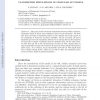Free Online Productivity Tools
i2Speak
i2Symbol
i2OCR
iTex2Img
iWeb2Print
iWeb2Shot
i2Type
iPdf2Split
iPdf2Merge
i2Bopomofo
i2Arabic
i2Style
i2Image
i2PDF
iLatex2Rtf
Sci2ools
CORR
2010
Springer
2010
Springer
Clandestine Simulations in Cellular Automata
This paper studies two kinds of simulation between cellular automata: simulations based on factor and simulations based on sub-automaton. We show that these two kinds of simulation behave in two opposite ways with respect to the complexity of attractors and factor subshifts. On the one hand, the factor simulation preserves the complexity of limits sets or column factors (the simulator CA must have a higher complexity than the simulated CA). On the other hand, we show that any CA is the sub-automaton of some CA with a simple limit set (NL-recognizable) and the sub-automaton of some CA with a simple column factor (finite type). As a corollary, we get intrinsically universal CA with simple limit sets or simple column factors. Hence we are able to 'hide' the simulation power of any CA under simple dynamical indicators.
Related Content
| Added | 09 Dec 2010 |
| Updated | 09 Dec 2010 |
| Type | Journal |
| Year | 2010 |
| Where | CORR |
| Authors | Pierre Guillon, Pierre-Etienne Meunier, Guillaume Theyssier |
Comments (0)

